- Home
- Julian Stockwin
Stockwin's Maritime Miscellany
Stockwin's Maritime Miscellany Read online
Contents
COVER
ABOUT THE BOOK
ABOUT THE AUTHOR
TITLE PAGE
EPIGRAPH
FOREWORD
Chapter 1. NAUTICAL FACTS & FEATS
Chapter 2. SEA EXPLORERS, DISCOVERERS & INVENTORS
Chapter 3. THE SAILORS’ WOODEN WORLD
Chapter 4. BRINY BELIEFS & SUPERSTITIONS
Chapter 5. MARITIME MISFORTUNES
Stockwin’s TOP 25 MUSEUMS & HISTORIC SHIPS
GOLDEN AGE OF SAIL – SOME KEY DATES
SIZE MATTERS
GLOSSARY
PICTURE ACKNOWLEDGEMENTS
INDEX
COPYRIGHT
About the Book
A ditty bag: a small bag used by seamen in the days of old to store small items and persnal treasures.
Full of fascinating facts and sea lore, this book is Julian Stockwin’s own ditty bag of wonders from the Golden Age of Sail. Ranging from the heroic voyages of discovery in the fifteenth century through the iconic Napoleonic wars to the glorious era of the greyhounds of the sea, the clipper ships, he celebrates and explores a colourful world we will never see again.
Drawing on Julian’s own experience in the Navy, both on the lower deck and as an officer, it spans a variety of topics – Nautical Facts & Feats; Sea Explorers, Discoverers & Inventors; The Sailors’ Wooden World; Briny Beliefs & Superstitions and Maritime Misfortunes. Scattered throughout are Salty Sayings, phrases inherited from the sea and very much in use today such as ‘high and dry’, ‘the coast is clear’ and ‘first rate’. Also included is Stockwin’s Top 25 list of maritime museums and historic ships around the world for anyone who wishes to explore further.
Charmingly illustrated with nostalgic black and white line drawings, both old salts and nautical novices will delight in this entertaining and eclectic miscellany.
About the Book
As far back as he can remember Julian Stockwin has always loved the sea. At the age of 14 he was sent to Indefatigable, a sea-training school. He joined the Royal Navy at 15 before transferring to the Royal Australian Navy where he served as a Petty Officer in Vietnam. After leaving the Navy, Stockwin practised as an educational psychologist. He lived for some time in Hong Kong, where he was commissioned into the Royal Navy Reserve. He was awarded the MBE and retired with the rank of lieutenant commander. Stockwin now lives in Devon where he writes the internationally-acclaimed Thomas Kydd series. More information can be found on his website www.julianstockwin.com
‘But this learned I from my dear mother –
The kiss of a seaman’s worth two of another’
– Anon, Roxburghe Ballads, seventeenth century
Foreword
I’ve no idea where my love of Neptune’s Realm comes from, but it’s been a part of me from as far back as I can remember. My mother tells of a very small boy once bringing home a dead sea-bird because it stank so richly of the sea. While none of my immediate family had any salty connections there was a distant relative, Tom Clay, who had sailed around the Horn in the lovely clipper Cutty Sark, and his stirring tales of iron men in wooden ships could only strengthen my determination to become a sailor. At school I was a dismal scholar, all the time daydreaming of sailing over the horizon to some foreign shore. My father hoped to knock this nonsense out of me by sending me to a tough sea-training school at the age of 14, but it didn’t work and I joined the navy as soon as I could. I had adventures around the world and served both on the lower deck and later as an officer. After swallowing the anchor it’s such a joy to have come full circle and earn my living now by writing about the sea, which I’ve done for the past ten years.
When I was approached by Ebury Press I jumped at the challenge of compiling a selection of maritime wonders from the days of sail. Before steam came along man still had to woo the sea, utterly dependent on the wind and the currents – and his nautical skills. The great historical sweep of five centuries that began with the heroic voyages of discovery in the fifteenth century and culminated in the glorious reign of the clipper ship in the 1860s is truly the Golden Age of Sail.
I wish you Fair Winds!
JULIAN STOCKWIN
2009
THE GOLDEN AGE of Sail is the mother lode for history’s most colourful people and amazing incidents. Where else could you find characters like English seaman turned samurai Richard Adams, who did much to open up Japan to the West in the early seventeenth century; Admiral Richard (‘Black Dick’) Howe of the Royal Navy, who was said never to smile unless a battle was about to begin, and the Russian tsar who loved to disguise himself as a common shipwright and work in an English dockyard? Yet the fairer sex could sometimes demonstrate just as much courage and determination as their men at sea. The last invasion of Britain was not in 1066 at Hastings but in 1797 at a little town in southwest Wales, where troops who had been landed from four French warships surrendered because of the feisty local women.
One of the notable characteristics of this era was sheer bloody-mindedness in the face of incredible odds. When Sir Richard Grenville chose to stand and fight the Spanish in 1591 he was outgunned and outnumbered 53 to one. William Bligh achieved one of the most remarkable feats of seamanship and survival of all time: after mutineers set him adrift in an open boat, he completed an epic voyage across the Pacific Ocean without the loss of a single man. At the Battle of Trafalgar the diminutive French captain Jean Lucas and his crew fought heroically in Redoutable as their decks were torn open and guns shattered. When he eventually surrendered just one mast remained upright. The butcher’s bill was horrendous – 88 per cent of the crew were either killed or injured.
It was an age when a barren rock could be commissioned as a sloop of war, when a duel to the death could be fought by a naval officer over a dog, and when the French could say of the English that they felt it wise to execute an admiral from time to time pour encourager les autres. And who could not smile today at the gritty humour of the handsome Irish master’s mate Jack Spratt? When told that his badly mangled leg must be amputated he refused and pointing to his good leg declared, ‘Where shall I find a match for this?’
Facing almost certain death at sea, William Bligh is cast adrift by Bounty mutineers.
THE WAR OF JENKINS’S EAR
It may be history’s most oddly named conflict. Captain Robert Jenkins was an English sea captain whose ship Rebecca was boarded by the Spanish as he sailed back to England from Jamaica in 1731. During the ensuing skirmish one of Jenkins’s ears was severed and he pickled it in a bottle. Although he complained of his treatment on his return, that was pretty much that for another seven years.
Friction had been increasing between the English and Spanish over trade rights in Central America, and in 1738 Jenkins was summoned to Parliament to recount his story and produce the now shrivelled body part. This resulted in outrage throughout the country but more importantly it was an excuse to teach the Spanish a lesson. England declared war on Spain the following year – and thus began the War of Jenkins’s Ear.
Admiral Vernon was ordered to ‘destroy the Spanish settlements in the West Indies and distress their shipping by every method whatever’. He took the city of Porto Bello in November 1739, a victory that was greeted with much celebration in England, giving rise to a number of commemorative names including Portobello Road in London.
Vernon took Porto Bello with just six ships.
‘NEVER A STRUGGLE MORE MARVELLOUS OR MORE CLOSELY CONTESTED’
In the nineteenth century a sailing ship of great beauty, grace and speed evolved – the clipper. Carrying a very large spread of sails on three or more masts, these were the greyhounds of the sea and ideally suited for h
igh-value, low-bulk cargoes such as China tea. They achieved record-breaking sailing times, often in spectacular races with other clippers to be the first to land their cargo.
The Great Tea Race of 1866 was a nail-biting event from start to finish. In the spring nine clippers assembled at the Pagoda Anchorage of the Min River at Foochow, jostling to take on board the new season tea as quickly as possible. The first vessel to unload the precious cargo in London could claim an extra ten shillings a ton in freight charges. Huge sums of money were bet on the outcome of the race, and English tea merchants in Mincing Lane were ready to begin bidding the moment they tasted samples of the sought-after first tea of the season from the fastest clipper.
Its 24,000-km route took the ships across the South China Sea, through the Sunda Strait of Indonesia, across the Indian Ocean, round the Cape of Good Hope and up the Atlantic Ocean to the English Channel. The five leading vessels were often in sight of each other, passing and repassing as they knifed through the waves.
The race generated great excitement as the fastest vessels entered British waters virtually neck and neck. The Daily Telegraph of 12 September reported: ‘A struggle more closely contested or more marvellous… has probably never before been witnessed. Taeping… arrived at the Lizard in the same hour as Ariel, her nearest rival, and then dashed up the Channel, the two ships abreast of each other. During the entire day they gallantly ran side by side, carried on by a strong westerly wind, every stitch of canvas set, and the sea sweeping their decks as they careered before the gale.’
Taeping, carrying 695 metric tons of tea, won the race by a whisker, taking 99 days to sail to London and docking just half an hour ahead of Ariel. In the spirit of sportsmanship the two ships’ owners split the winner’s premium.
Taeping and Ariel.
* * *
AT CLOSE QUARTERS – at close range. DERIVATION: in the seventeenth century hand-to-hand fights when ships were boarded by the enemy were known as ‘close-fight’ engagements, and the term was also applied to the barriers the sailors erected to keep assailants at bay. By the mid-eighteenth century this confined defensive space had come to be known as ‘close quarters’.
* * *
IT’S NOT A ROCK, IT’S A SHIP!
In January 1804 the Royal Navy took possession of a rock, 180 m high, 1.6 km off Martinique, the centre of French power in the Caribbean – and then declared the barren pinnacle a warship. This uninhabited islet was an ideal site for establishing a blockade as it dominated the approach to Port Royal, the capital of Martinique. And, with a visibility of 64 km from the summit, a signal station could be set up to pass on intelligence about French ship movements.
However, there were a large number of obstacles to be overcome. The only landing spot was on the western side; heavy swells and narrow rock ledges made any attempt to do so very chancy; and there was no food or water on the island.
Commodore Samuel Hood had reconnoitred the rock in his flagship HMS Centaur and was well aware of the challenges it posed. Fortunately his first lieutenant, James Maurice, was an amateur mountaineer and he went ashore and found a route up the sheer rock face.
A working party with several weeks’ provisions was landed. They found dry caves where they set up operations. With the aid of pitons and ropes the nimble seamen, used to swarming up rigging, scaled the heights and installed rope ladders. One hazard they had not bargained on, however, was the deadly local snake, the fer-de-lance.
Eventually the defences of Diamond Rock comprised two 24-pounders just above sea level, a 24-pounder halfway up and two 18-pounder cannon right on top. Getting these massive weapons in place was a heroic undertaking which took long backbreaking days at the capstan. After a line was run ashore a cable was rigged from the mainmast of the anchored Centaur to the top of the cliff, and the big guns were painstakingly hauled to the rock using an ingenious sling. Then began the formidable task of landing water and provisions for 120 men.
Maurice was installed ashore as commander, and in front of the assembled sailors and marines he proudly read out his commission. A pennant was run up and Diamond Rock was officially rated a sloop of war.
An artist, John Eckstein, obtained Hood’s permission to record for posterity one of the most outstanding achievements of the age of sail. He painted a series of aquatints which were published in 1805. Eckstein was amazed at the ingenuity of Jack Tar and said, ‘I shall never more take my hat off for anything less than a British seaman.’
For a year and a half the British fired at any passing French ship and proved such a thorn in the side of Admiral Villeneuve on his way to his destiny at Trafalgar that he eventually threw his entire battle fleet at the rock. On 2 June 1805 Captain James Maurice surrendered. It was not French firepower that defeated him, however, but an earth tremor which cracked the water cistern he had installed.
In the Royal Navy, there was (and is to this day) an automatic court of enquiry if a captain lost his ship, whatever the reason. This rule applied even if the ship was a rock, so a court was convened aboard HMS Circe on 24 June. It did not take long to reach the verdict that Maurice and his officers had done everything in their power to the very last in the defence of the rock and against a most superior force.
‘THE SEA WOLF’
Thomas Cochrane was one of the most daring and successful captains of the Napoleonic wars, called ‘le loup des mers’, the sea wolf, by Napoleon Bonaparte. In the course of his career he captured 50 enemy ships in just one year, was dismissed from the Royal Navy for alleged fraud, commanded the navies of Chile, Brazil and Greece, and was eventually reinstated in the Royal Navy as an admiral. He was a radical politician, an early advocate of many technological innovations that were later adopted by the navy and the inspiration for a number of fiction writers.
But in many ways Cochrane was his own worst enemy and made several powerful foes, especially in his political campaign against corruption in the navy. Earl St Vincent, although sympathetic to some of Cochrane’s beliefs, said of him that he was ‘mad, romantic, money-getting and not truth telling’.
One of Cochrane’s most famous exploits occurred on 6 May 1801 when he took the 32-gun Spanish frigate El Gamo and its crew of 300. His vessel, the 14-gun brig-sloop HMS Speedy, had a crew of just 50. On spotting El Gamo Cochrane hoisted the Stars and Stripes (whose country Spain was not at war with) and sailed directly towards her. When he drew close he lowered this flag, hoisted the Union Jack and began firing. His first salvo killed the Spanish captain. Cochrane stormed the ship with a boarding party which included his entire crew, except the ship’s surgeon who was left in charge of the wheel. A ferocious fight with cutlasses, axes and pikes ensued. At one point Cochrane called loudly for another 50 (fictitious) reinforcements to follow – and the Spanish surrendered.
But the plucky little ship’s luck did not last and Speedy was later taken by the French, who gave her to the Pope renamed San Paulo.
Personally bold and adventurous, Cochrane nevertheless took great pains to ensure the safety of his men and was greatly admired by them. To his ship’s company he was a second Nelson and they were intensely loyal to him.
* * *
Saving The Dog
Cochrane once risked his life for a dog. Having lit the fuse on a fireship packed with explosives he was being rowed away when he remembered the ship’s pet was still aboard. He hastily turned the boat back and rescued the dog. Ironically, had he not been delayed by the rescue his boat would have been directly under the falling wreckage and all aboard probably killed. As it happened, the deadly debris flew right over the top of them.
* * *
Cochrane’s kindness could extend to the enemy. In command of the frigate HMS Pallas he captured the Spanish ship La Fortuna laden with gold and silver and valuable merchandise. Troubled when he heard of the hardship that would be caused to the Spanish captain and his merchant passenger in losing their entire private fortune that was aboard the vessel, Cochrane gained the agreement of his officers and seamen t
hat the two Spaniards should be given 5,000 Spanish dollars each so that they and their families would not be ruined.
Thomas Cochrane, 10th Earl of Dundonald.
NOT A MARK ON HIM
As the ship was about to engage the enemy, Captain Thomas Hardy’s clerk Thomas Whipple was checking some details with a midshipman on the deck of HMS Victory when a cannonball slammed by. Whipple dropped dead instantly without even a bruise on his body, but his companion remained completely unhurt. This phenomenon had a variety of names – ‘wind of ball’, ‘wind of the shot’, ‘vent du boulet’ and ‘breath of the cannon ball’. It is a form of blast injury caused by a rapid change in pressure, particularly in air-containing organs of the body. One naval surgeon in Nelson’s time described it as a ‘peculiar accident… common in engagements at sea’, and went on to explain:
If a cannon ball in its flight passes close to any part of the body, that part is rendered livid and benumbed for some time. It is most dangerous when it approaches the stomach and has often in such cases proved instantaneously fatal without the least mark of injury. At other times marks of violence are conspicuous. What is remarkable is this, that the wind of a ball had never been fatal on the head.
* * *
JURY RIG – something assembled in a makeshift manner. DERIVATION: in sailing ships it was sometimes necessary to improvise a temporary replacement for an item such as a damaged mast or a disabled rudder and thus enable the vessel to keep going until the nearest port could be made and the stop-gap replaced. The origin of ‘jury’ is not known, but it has been suggested that sailors coined it as a shortened form of ‘injury-rigged’.

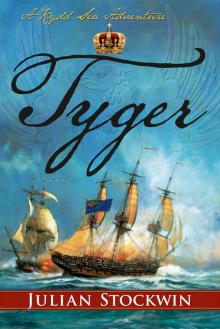 Tyger: A Kydd Sea Adventure (Kydd Sea Adventures)
Tyger: A Kydd Sea Adventure (Kydd Sea Adventures) Seaflower - Kydd 03
Seaflower - Kydd 03 6-Tenacious
6-Tenacious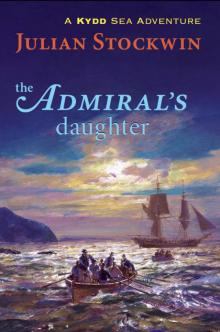 The Admiral's Daughter
The Admiral's Daughter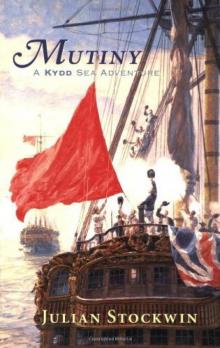 Mutiny k-4
Mutiny k-4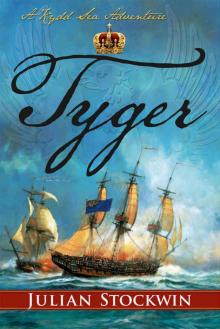 Tyger
Tyger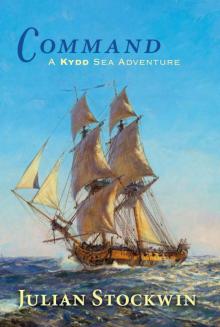 Command
Command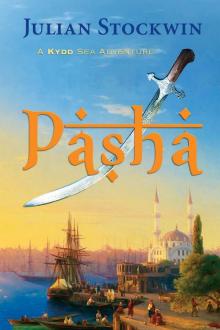 Pasha
Pasha Artemis k-2
Artemis k-2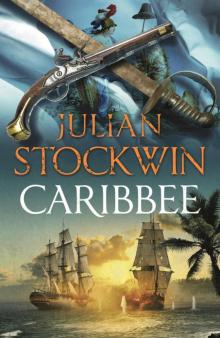 14-Caribbee: A Kydd Sea Adventure
14-Caribbee: A Kydd Sea Adventure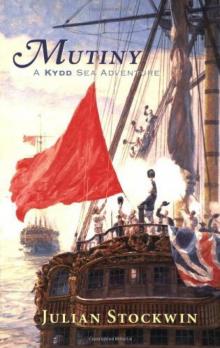 Mutiny - Kydd 04
Mutiny - Kydd 04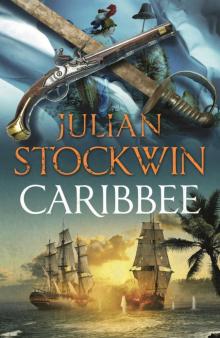 Caribbee
Caribbee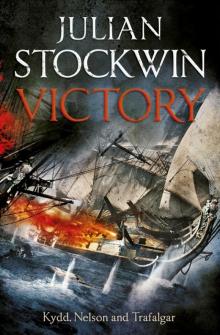 Victory
Victory Quarterdeck
Quarterdeck Artemis - Kydd 02
Artemis - Kydd 02 The Powder of Death
The Powder of Death Conquest
Conquest Betrayal tk-13
Betrayal tk-13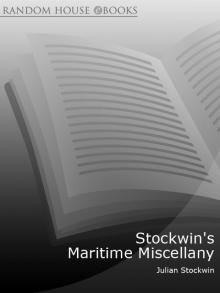 Stockwin's Maritime Miscellany
Stockwin's Maritime Miscellany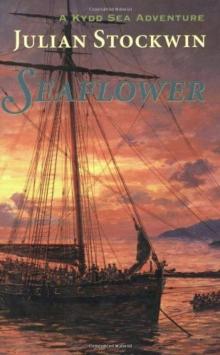 Seaflower: A Kydd Novel
Seaflower: A Kydd Novel Mutiny
Mutiny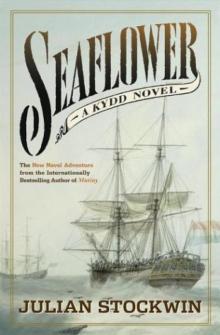 Seaflower k-3
Seaflower k-3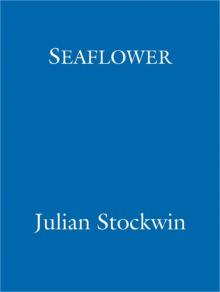 Seaflower
Seaflower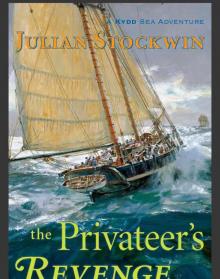 The Privateer's Revenge
The Privateer's Revenge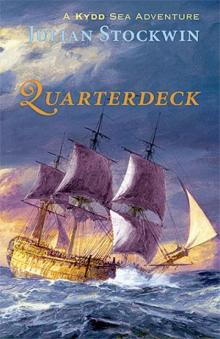 Quarterdeck: A Kydd Sea Adventure
Quarterdeck: A Kydd Sea Adventure Kydd
Kydd Artemis
Artemis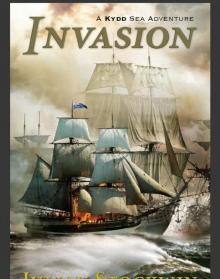 Invasion
Invasion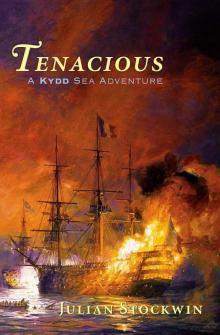 Tenacious
Tenacious 06 - Tenacious
06 - Tenacious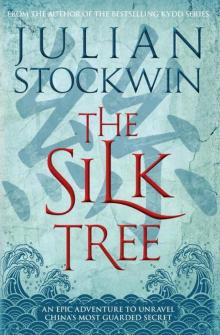 The Silk Tree
The Silk Tree